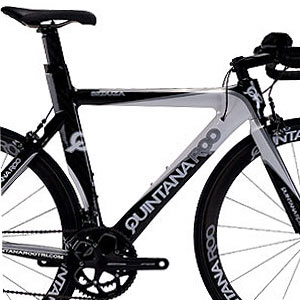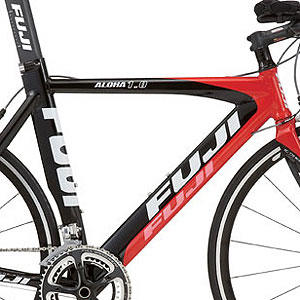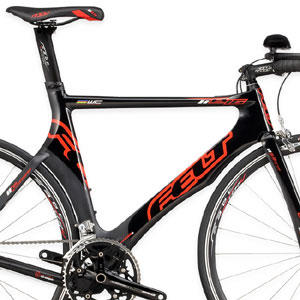
Kuota
When the K Factor first arrived for sale some years back, it was a round-tubed sorta-road, sorta-tri bike. It has since morphed into the K Factor SL, which is an oddly named revision since the most obvious and impactful changes were in the tube profiles. The bike got aero, or at least quite aero looking. Yes it got lighter, but light is only somewhat sexy nowadays. Curves are what's really sexy, and the K Factor SL's got them.
K Factor
The geometry did not change, save for a new seat post that, because of the orientation of the post's hardware, steepened the relative seat angle from 75° to 76°. The post allows the rider to reach a relative seat angle of approximately 78° (steeper if you're a short rider, shallower if you're a taller rider, refer to your high school trigonometry for why this is).
All this is true of the bike in the 4 sizes between S and XL. The smallest size, XS, has a 78° seat angle and is the pick of the litter. This is a great option for a female, and along with the QR Seduza also written about here represent two of the very best tri bike options for women under 5'6".
The K Factor SL sells for $2250 in its cheapest complete bike iteration, which means it's one of the lowest-priced tri bikes with an all-carbon frameset. Let's talk about how and who this bike fits before we talk about all the parts and the value and whatnot.
Kuota is a bit like Orbea in its geometric approach to its various bike models. In each case, the upper-end bikes diverge greatly from the lower-end, not only in price but in how they fit. Kuota's K Factor, and Orbea's Aletta, have 160mm and 185mm head tubes respectively in their largest sizes. But Kuota's Kueen K and Orbea's Ordu have head tubes of 135mm and 111mm respectively in their largest sizes.
What's our take-away from this? Three things: First, know that—as opposed to Cervelo and Felt—all Kuotas are not created equal, in terms of geometry and fit. Second, even inside it's own size run, a K Factor in size XL fits a different kind of person than a K Factor in XS (the XL fits not only a taller person, but a different style of rider, than does the same bike in XS). And third, because of the variability in rider profile, you may need to change the aerobars that come on a K Factor before it's your perfect bike.
Most notably, the Profile Design aerobars that come with your K Factor probably will not work. It's not that the bars are bad, they're not, they're good. They're just a bad thematic match with the K Factor frame. Hearken up a couple of paragraphs, to those head tube lengths. This makes the K Factor a taller bike, relative to its length, than, say, Kuota's Kalibur, which is also a taller bike than the Kueen K. So an aerobar with high profile armests is not a good match.
Fortunately, these bikes are sent to retailers "knock down," which means they are assembled at your LBS. Better this way, because the retailer can absorb these Profile aerobars into his inventory and slap on some Visiontech clips would be a good match for the K Factor. Or, the retailer can order this bike from Kuota with a Profile Design Sonic CSX aerobar (that's one of two alternative specs to the T2+ aerobars).
Otherwise, the bike is spec'd nicely, with Ultegra front and rear derailleurs, and 105 chain and cassette. The wheels are Shimano RS10, not a common wheel, but a decent mid-priced OE wheel found on a few other mid-priced tri bikes, like Scott's Plasma 10. The crank is a SRAM Elita, certainly a good crank out of SRAM's Truvativ braintrust, but why deviate from Shimano just for a crank? I'll tell you why. Shimano's cranks and brake calipers, among the elements in its gruppo, tend toward the pricey side; these are the Shimano components typically omitted, casualties of cross- or down-spec'd. But with cranksets usually the cross-spec goes to FSA. In this case, SRAM won out.
If you don't ride the bike especially steep (if you ride 78° or shallower), and/or if God put longer legs on you relative to the rest of your body, the K Factor is a nice bike at a nice price. Just know that the XS version is altogether a different beast. It's made for steep riding and that's a bike any gal could win Kona aboard. It's the other sizes that trend toward the taller, narrower geometric stereotype, and that's where you'll have to be careful to pair the K Factor with an aerobar that will keep you low enough in front.

Quintana Roo
This Seduza is a singular example of this American company with a Mexican name's resurgence. It's a full-carbon monocoque chassis with all the sex features, which I will not delineate because I've already done so ad nauseum in other reviews.
Seduza
It sells complete for $1999 and I can't think of its equal in the marketplace, such calculation based on the return on your invested peso.
To give you an idea of this bike's pedigree, it started its life in 2005 as the Lucero, and a complete bike at that time would've cost you more than double the price you'll pay today. The Lucero still exists, and the Seduza always was a slightly downscaled version of a frame that popped out of the same mold (expensive carbon instead of ridiculously expensive carbon).
In 2006 the Seduza sold complete at $3000 and it was a spankin' deal then. In the intervening years, this model has crept down in price as other, newer models debuted above it. But today's version is actually an upgrade over the original. The molds have been tweaked, steepening the former 76° seat angles to 78°, a bit of weight has been hogged out, and the lines smoothed for a slippery profile. And, a new seat post debuts in 2009 as well, more about that later.
You might think, at this price, and because there is a frame of this substance on the bike, that the parts must be on a par with those found on bikes sold at Walmart. Surprisingly, no. The derailleurs are Shimano 105 (front) and Ultegra (rear). Cassette and chain are both 105. The crank is an FSA Omega compact, and this shows the careful product management of the Seduza: most triathletes ought to be on 110mm bolt pattern cranks, with 50x34 chainrings. Instead of making you upgrade the crank at the point of sale, QR puts the crank on the Seduza as original equipment.
If you don't want the compact cranks on your Seduza, no problem, your retailer will be happy to swap them out at no charge, because he's got dozens or hundreds of 130mm bolt pattern cranks he's taken off other companies' ill-spec'd bikes; you LBS would love to absorb your more salable cranks into his inventory, replacing them with the boat anchors you're choosing to "upgrade" your Seduza with.
The aerobars are Visiontech clip ons, wheels are functional Alex 220 and tires are Conti Ultra Race.
The bike is made in four sizes, and they are properly graded and each size tends to fit a person of average proportion who wants to ride in a 77 to 79 degree relative seat angle. A new seat post is about to debut allowing riders who want to ride a bit steeper to easily get to that spot. To see what that post will look like, check the pic of QR's new CD 0.1. But this is a running change, and will not show up in stores until May and June. If you buy an "older" 2009 Seduza, showing up in stores quite soon, make sure you don't need a position steeper than what the prior-version seatpost gives you. If you do need that steeper position, maybe haggle with your retailer, and ask him to make that running change to you no-charge, or at his raw cost, when the new seatposts show up.
Finally, the smallest size, 48cm, is built with 650c wheels and is a great choice for those 5'6" or shorter. It has a "stack" of 45.3cm and a "reach" of 39.4cm, making it very low in front for those who just can't find a bike small enough, yet it's also quite compact in length. This frame mold is made with a 78° seat angle, and I can't think of a better overall value for a woman who wants to move to a fast bike that fits very well, while nicely slotting into a reasonable price range.
In the spirit of full disclosure, and for those who don't know, I founded this company in 1987 and built it up through 1995, when I sold it to Saucony. I then managed it until 1999, when I left and started Slowtwitch. The company (currently and for most of this decade under the same umbrella ownership as Merlin and Litespeed) has had good and bad starts in the interim years, and we've tried to be faithful scribes when chronicling that process for our readers. We've been critical where the critique was warranted, which it often was. Very frankly, specific to its tri bike line, QR is just about all the way back. From the bottom (Tequilo) to the top (CD0.1) this bike line is muscular.
Unfortunately, a lot of retailers have experienced the fits and starts we've seen over most of this decade, and retailers tend toward a posture of once-burned-twice-shy. So, you might not find these bikes on showroom floors as often as you should find them, and that's too bad. But, do not be deterred. If you think a Seduza is your bike, just keep looking until you find it. Make sure it's a 2009, with the 2009 graphics, and if you need that steeper post to get the saddle forward enough, make sure it's on the Seduza you're buying, or will be on it at some point in the near future, once the post becomes available in the aftermarket.


